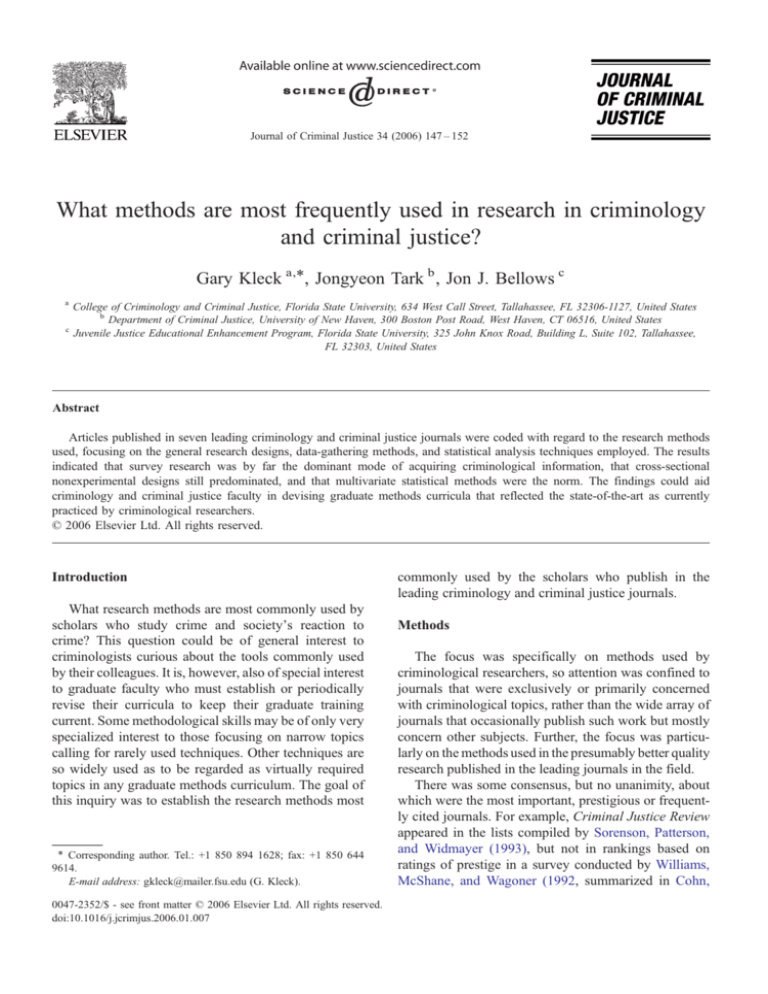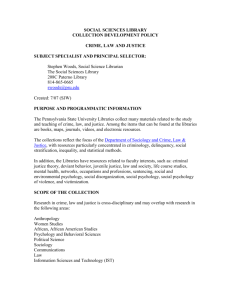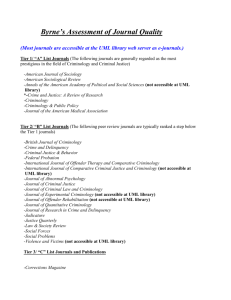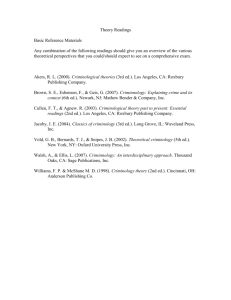
Journal of Criminal Justice 34 (2006) 147 – 152
What methods are most frequently used in research in criminology
and criminal justice?
Gary Kleck a,⁎, Jongyeon Tark b , Jon J. Bellows c
a
c
College of Criminology and Criminal Justice, Florida State University, 634 West Call Street, Tallahassee, FL 32306-1127, United States
b
Department of Criminal Justice, University of New Haven, 300 Boston Post Road, West Haven, CT 06516, United States
Juvenile Justice Educational Enhancement Program, Florida State University, 325 John Knox Road, Building L, Suite 102, Tallahassee,
FL 32303, United States
Abstract
Articles published in seven leading criminology and criminal justice journals were coded with regard to the research methods
used, focusing on the general research designs, data-gathering methods, and statistical analysis techniques employed. The results
indicated that survey research was by far the dominant mode of acquiring criminological information, that cross-sectional
nonexperimental designs still predominated, and that multivariate statistical methods were the norm. The findings could aid
criminology and criminal justice faculty in devising graduate methods curricula that reflected the state-of-the-art as currently
practiced by criminological researchers.
© 2006 Elsevier Ltd. All rights reserved.
Introduction
What research methods are most commonly used by
scholars who study crime and society's reaction to
crime? This question could be of general interest to
criminologists curious about the tools commonly used
by their colleagues. It is, however, also of special interest
to graduate faculty who must establish or periodically
revise their curricula to keep their graduate training
current. Some methodological skills may be of only very
specialized interest to those focusing on narrow topics
calling for rarely used techniques. Other techniques are
so widely used as to be regarded as virtually required
topics in any graduate methods curriculum. The goal of
this inquiry was to establish the research methods most
⁎ Corresponding author. Tel.: +1 850 894 1628; fax: +1 850 644
9614.
E-mail address: gkleck@mailer.fsu.edu (G. Kleck).
0047-2352/$ - see front matter © 2006 Elsevier Ltd. All rights reserved.
doi:10.1016/j.jcrimjus.2006.01.007
commonly used by the scholars who publish in the
leading criminology and criminal justice journals.
Methods
The focus was specifically on methods used by
criminological researchers, so attention was confined to
journals that were exclusively or primarily concerned
with criminological topics, rather than the wide array of
journals that occasionally publish such work but mostly
concern other subjects. Further, the focus was particularly on the methods used in the presumably better quality
research published in the leading journals in the field.
There was some consensus, but no unanimity, about
which were the most important, prestigious or frequently cited journals. For example, Criminal Justice Review
appeared in the lists compiled by Sorenson, Patterson,
and Widmayer (1993), but not in rankings based on
ratings of prestige in a survey conducted by Williams,
McShane, and Wagoner (1992, summarized in Cohn,
148
G. Kleck et al. / Journal of Criminal Justice 34 (2006) 147–152
Farrington, and Wright (1998, p. 26)). Criminal Justice
and Behavior was high in the ranks of journals assessed
by Sorenson et al. (1993) and Williams et al. (1992), but
not in the earlier assessments of Shichor, O'Brien, and
Decker (1981). Likewise, Law and Society Review
ranked high in lists generated by Regoli, Poole, and
Miracle (1982) but not in the citation-frequency
rankings of Cohn and Farrington (1990). These
differences were probably partly due to actual changes
in importance over time and partly to different methods
of assessing importance.
Attention was concentrated on the “consensus”
journals, those that had most consistently appeared in
these lists. It was also important to cover any newer
journals that could not be included in earlier lists
because the journals were created fairly recently. It
would be undesirable for the selection of leading
journals to be out of date, and thereby reflect prestige
confined to earlier eras. As it happens, one of the more
recent ranking efforts yielded a list of journals that met
all these requirements. Williams and his colleagues
(1992) asked a sample of over 250 members of the
Academy of Criminal Justice Sciences to rate, on a scale
from 0 to 10, the prestige of the leading criminology and
criminal justice journals. The following journals were
found to be the seven most highly rated (ratings in
parentheses): Criminology (CR, 8.7), Journal of Criminal Law and Criminology (JCLC, 8.2), Justice
Quarterly (JQ, 8.0), Journal of Research in Crime and
Delinquency (JRCD, 7.9), Crime and Delinquency (CD,
7.6), Journal of Criminal Justice (JCJ, 7.3), and Journal
of Quantitative Criminology (JQC, 7.3). Taking into
account the eras covered by various rating studies and
the years when journals began to publish, all these
journals also consistently appeared in the top ranks of
lists of leading journals in the field (Cohn & Farrington,
1990; Regoli et al., 1982; Shichor et al., 1981; Sorenson
et al., 1993). Articles in these seven journals therefore
were covered.
Readers might dispute the exact composition of
the list, and speculate about the resulting impact of
including or excluding particular journals that arguably should or should not have been included.
Therefore, results will be presented for individual
journals, as well as for the entire set of seven taken
collectively, enabling readers to see for themselves
how methods vary across journals and how conclusions might have differed had a given journal not
been included.
The analysis encompassed all original articles and
research notes in these seven journals. Editorial introductions, speeches, letters, corrections, book reviews,
comments on articles previously published in the same
journals, and author replies to those comment articles
were excluded. Each “case” in the analysis was an
original article.
The senior author created a coding protocol (available
from that author) and determined the coding for any
ambiguous cases. The junior authors, graduate students in
criminology and criminal justice, coded the articles. Each
article's journal, volume, issue number, and starting page
were recorded and each article was classified as to
whether it was (a) nonempirical, which would include
purely theoretical or conceptual papers, as well as
literature reviews with no original empirical evidence,
(b) empirical but exclusively descriptive, in the sense that
there was no direct testing of causal hypotheses, or (c)
empirical and analytical in the sense that it performed
some tests of causal hypotheses. The analyses covered all
empirical articles appearing in these seven leading
journals in calendar years 2001 or 2002.
Empirical articles were coded as to their general
research design. Did they use experimental methods
(i.e., the work involved researcher manipulation of
conditions to which subjects were exposed) or was
study purely nonexperimental? Did the research
consider evidence concerning: (1) individual persons
only, (2) macro-level units (e.g., the populations of
cities or states), or (3) both individuals and macro-level
units? Was the design (1) purely cross-sectional
(individuals or populations compared with each
other), (2) purely longitudinal (a single population
studied at multiple points in time), or (3) both crosssectional and longitudinal (multiple populations studied
at multiple points in time)?
Each empirical article was also coded for every datagathering technique that was originally used to generate
the study's information. This would include methods
used by earlier researchers to gather information that
was then subjected to secondary analysis by the authors
of the article being coded. Since articles often were
based on more than one type of data, any one article
could be coded for however many techniques happened
to be used in the research. Survey-based articles could
also be coded affirmatively for more than one survey
type. For example, the National Crime Victimization
Survey uses both face-to-face and telephone interviewing, so articles using this source would be coded as
being based on both types of surveys.
Each article was coded for whether or not any of the
following data-gathering techniques were used: (1)
telephone interviews, (2) formal personal (face-to-face)
interviews, (3) mail questionnaires, (4) other selfadministered (e.g., classroom) questionnaires, (5)
G. Kleck et al. / Journal of Criminal Justice 34 (2006) 147–152
compilations of official statistics pertaining to macrolevel units (e.g., the Uniform Crime Reports), (6)
archival information drawn from existing records
concerning individual persons or events (e.g., sentencing
studies using court records, recidivism studies using
parole records, studies of violent crimes using police
offense reports, etc.), (7) experimental observations, (8)
historical methods such as reading newspaper articles,
public speeches, diaries, memoirs, etc., (9) informal
interviews of the sort commonly conducted in field
research, (10) direct observation of behavior by
researchers, and (11) miscellaneous other methods.
Articles were also coded as to whether the authors
gathered their own data (primary data) or analyzed data
previously gathered by others (secondary data). This
distinction is important because it bears on the importance of learning how to locate and manage existing
datasets.
Finally, the empirical articles were coded for all
statistical data analysis techniques employed. Once
again, articles could be coded affirmatively for as
many analytic techniques as were applied in the
article. Articles were coded for (1) univariate descriptive statistics such as means, medians, and standard
deviations, (2) bivariate statistics such as correlations
and tabular measures of association, (3) ordinary least
squares regression (OLS) and weighted least squares
(WLS) regression, (4) logistic regression and other
techniques for analyzing limited dependent variables,
such as probit analysis, Tobit, etc., (5) structural
equations modeling, including covariance modeling,
analysis of latent variables, two-stage least-squares
estimation, etc., (6) time series and interrupted time
series methods such as ARIMA, Box Jenkins/BoxTiao methods, and variants thereof, (7) hierarchical
linear modeling (HLM), (8) factor analysis, (9) event
history and survival analysis, (10) Poisson and
negative binomial models for analyzing count data,
and (11) miscellaneous other multivariate analysis
methods.
Findings
Research designs
Table 1 displays the prevalence of various research
designs and data-gathering methods used in criminology and criminal justice research published in 2001–
02. Most (62 percent) work published in the leading
journals was done at the individual level. Despite the
obvious advantages of situating individuals in their
macro-level contexts, multi-level research remained
149
unusual, accounting for only 3 percent of empirical
articles. Further, most work done at either the individual
or macro-level of analysis was cross-sectional in nature:
45 percent of articles were based on individual-level,
purely cross-sectional analyses and another 15 percent
were based on macro-level purely cross-sectional
analyses.
Data-gathering methods
The most striking finding concerns the data-gathering
methods used in this field. Survey research dominates
the field of criminology and criminal justice. No other
method rivals survey methodology as a way of gathering
information on crime, criminals, and society's reaction
to crime. Some kind of formal survey was used to
generate information used in 45 percent of all empirical
research articles published in the field's leading journals,
compared to archival data, mostly drawn from criminal
justice records, which was used in 32 percent of the
articles, and official statistics concerning macro-level
units, which were used in 26 percent of articles.
Experimental research generated data for only 4 percent
of the articles published in the seven journals. This
would likely be different if journals oriented towards
psychological research, such as Criminal Justice and
Behavior, had been included in the study. Nevertheless,
even taking this into account, it was unlikely that
experimental methods were used in more than a small
fraction of crime studies.
Likewise, the principle tools used in qualitative field
research, informal interviews and direct observation,
were used in only 12 percent of research. Even this
modest figure, however, overstated the prevalence of
research that was primarily qualitative in character,
since many of the articles using these methods were
primarily quantitative articles that were supplemented
with a handful of informal interviews, such as statistical
analyses of sentencing patterns supplemented by a few
interviews with judges. If a primarily qualitative article
was defined as one using informal interviewing or direct
observation (including participant observation), but not
using multivariate statistical methods (i.e., articles using
multivariate methods were excluded), only 4.5 percent
of articles were qualitative. This prevalence did not vary
substantially across journals.
Secondary analysis of existing datasets is central to
criminological research. Among empirical articles, no
less than 58 percent used secondary data. This might
reflect the difficulty and expense of original data
gathering. It also implies the importance of methodological training in how to identify and obtain existing
150
G. Kleck et al. / Journal of Criminal Justice 34 (2006) 147–152
Table 1
General research methods used in criminological research
All seven journals
CR
JCLC
JRCD
CD
JCJ
JQC
JQ
Total number of articles
Percent empirical
375
81.3
63
90.5
43
23.3
33
90.9
55
67.3
93
92.5
30
100
58
94.8
Research design (percent)a
Individual-level CX only
Individual-level CT only
Individual and macro-level
Macro-level, CX only
Macro-level, CT only
Macro-level, CX and CT
305
45.2
13.8
3.0
15.1
11.8
4.6
57
35.1
5.3
8.8
15.8
10.5
5.3
10
0.0
20.0
0.0
0.0
80.0
0.0
30
36.7
23.3
0.0
16.7
6.7
13.3
37
35.1
10.8
2.7
21.6
18.9
2.7
86
62.8
12.8
1.2
10.5
7.0
1.2
30
30.0
30.0
3.3
10.0
13.3
13.3
55
56.4
10.9
1.8
21.8
5.5
1.8
Data-gathering methods
Total number of empirical articles
Some kind of formal survey (percent)b
Telephone survey
Face-to-face survey
Mail survey
Non-mail self-administered survey
Official statistics
Archival data
Experimental data
Historical methods
Informal interviews
Direct observation
Qualitative researchb
305
45.1
9.0
21.2
10.6
22.1
25.6
31.8
4.3
3.0
7.6
6.2
4.5
57
54.0
12.5
40.4
1.8
17.9
28.1
28.1
1.8
1.8
12.3
10.5
6.3
10
0.0
0.0
0.0
0.0
0.0
70.0
70.0
0.0
10.0
0.0
0.0
0.0
30
51.5
7.1
28.6
3.6
30.0
16.7
20.0
3.3
0.0
6.7
3.3
6.1
37
34.5
5.6
8.3
19.4
25.0
29.7
48.6
5.4
2.7
22.2
5.4
5.5
86
57.0
9.3
16.3
16.3
23.3
16.3
26.7
5.8
3.5
1.2
5.8
3.2
30
43.3
13.3
20.0
6.7
20.0
33.3
23.3
0.0
0.0
0.0
0.0
0.0
55
56.9
7.3
18.2
12.7
23.6
27.3
36.4
7.3
5.5
9.1
9.1
8.6
CR = Criminology, JCLC = Journal of Criminal Law and Criminology, JRCD = Journal of Research in Crime and Delinquency, CD = Crime and
Delinquency, JCJ = Journal of Criminal Justice, JQC = Journal of Quantitative Criminology, JQ = Justice Quarterly, CX = cross-sectional, CT =
cross-temporal.
a
Of empirical articles, percent that used.
b
Informal interviewing or direct observation, but no statistics beyond univariate.
datasets relevant to one's research topic, as well as how
to manage and analyze data gathered by others.
Data analysis techniques
Table 2 displays the findings on the prevalence
of the various statistical techniques used to analyze
criminological data. Nearly nine out of every ten
empirical articles used some kinds of univariate
statistics, while 73 percent used some bivariate
statistics, and nearly three-quarters used one type or
another of multivariate statistics. The most common
multivariate methods by far were OLS (or WLS)
regression and logistic regression or similar limited
dependent variable methods. While the field is
undoubtedly moving towards more complex statistical
methods, each of the other multivariate methods was
used in less than 7 percent of the empirical articles.
On the other hand, collectively speaking, one or more
of the methods more advanced than OLS were used in
50 percent of the articles. This is a reflection of the
fact the more advanced methods are often used to deal
with very specialized problems, such as two-way
causation, dependent variables with censored distributions, or nonindependent errors. The methods are
essential to dealing with the particular problems to
which they are applied, but each of the problems
arises relatively infrequently. Thus, while it is clear
that advanced statistical methods of some sort are
important tools in the field, it is not clear which
particular ones are the most important.
Regarding differences across the seven journals,
JCLC was the most deviant case. As a mixture of both
law review and criminology journal, it is perhaps not
surprising that over three-quarters of its articles were
nonempirical, and its few (n = 10) empirical articles
were less likely to involve multivariate statistical
analysis. Conversely, articles in JQC showed the
highest rate of use of advanced multivariate statistical
methods. These exceptions aside, the journals were
more similar than different in the array of methods
used in their empirical articles. In any case, since the
G. Kleck et al. / Journal of Criminal Justice 34 (2006) 147–152
151
Table 2
Data analysis techniques used in empirical criminological research
Total number of empirical articles
Univariate statistics (percent)a
Bivariate statistics
Some kind of multivariate statistics
OLS/WLS
Limited dependent variable methods
Poisson/negative binominal
Structural equation modeling
Hierarchical linear modeling
ARIMA
Factor analysis
Event history/survival analysis
Multivariate beyond OLS/WLS
Multivariate beyond OLS/limited DVb
All seven journals
CR
JCLC
JRCD
CD
JCJ
JQC
JQ
305
88.9
73.4
72.5
31.8
28.5
4.6
6.6
5.6
2.3
4.3
0.7
50.2
25.9
57
82.5
86.0
86.0
38.6
36.8
10.5
10.5
14.0
3.5
3.5
0.0
66.7
40.4
10
80.0
30.0
20.0
10.0
10.0
0.0
0.0
0.0
0.0
0.0
0.0
10.0
0.0
30
73.3
86.7
76.7
20.0
30.0
3.3
23.3
6.7
3.3
10.0
0.0
63.3
36.7
37
94.6
73.0
67.6
35.1
35.1
0.0
0.0
2.7
5.4
5.4
2.7
43.2
16.2
86
91.9
66.3
59.3
31.4
16.3
2.3
2.3
1.2
0.0
7.0
0.0
32.6
17.4
30
90.0
56.7
96.7
36.7
30.0
16.7
3.3
6.7
3.3
0.0
0.0
73.3
43.3
55
96.4
81.8
76.4
30.9
36.4
0.0
7.3
5.5
1.8
0.0
1.8
52.7
20.0
CR = Criminology, JCLC = Journal of Criminal Law and Criminology, JRCD = Journal of Research in Crime and Delinquency, CD = Crime and
Delinquency, JCJ = Journal of Criminal Justice, JQC = Journal of Quantitative Criminology, JQ = Justice Quarterly, OLS = Ordinary least squares,
WLS = weighted least squares, ARIMA = autoregressive integrated moving average.
a
Percent of empirical articles that used.
b
Multivariate statistics beyond OLS/WLS or limited dependent variable methods.
journals each averaged less than forty-four articles
over the two-year period, any further conclusions
about detailed differences across journals are likely to
be unstable.
Implications for graduate training in criminology
and criminal justice methods
If doctoral students are to be properly trained to carry
out research, or to be able to critically read and assess
the research of others, doctoral methods curricula will
need to cover the research methods most commonly
used in their field. The choice of courses for doctoral
students is individualized to some degree, being
composed of two components: (1) required or standard
courses that all doctoral students take, because they are
likely to be useful for most scholars in the discipline,
and (2) optional courses of more specialized value to
research in the areas that a given individual student
plans to explore, in either a dissertation or other work.
The findings suggest some ways in which the required
methods curriculum should go beyond the fairly
standard “omnibus” methods course that covers all the
commonly used techniques, but fairly superficially. A
curriculum that accurately reflects the nature of the
discipline would also give special emphasis to survey
research methods, as well as the use and limitations of
official statistics and criminal justice archival records. It
would also provide required statistical course work that
covered univariate and bivariate statistics, ordinary least
squares and logistic regression. These courses could
then be followed up by more individualized elective
coursework tailored to the particular needs of each
student, focusing in depth on whichever advanced
statistical methods or specialized data-gathering strategies were appropriate. Regarding statistical methods,
one option would be a course surveying three or four of
the relatively more frequently used advanced statistical
topics, such as structural equation modeling, hierarchical linear modeling, factor analysis, and perhaps Poisson
regression. The topics covered might be rotated from
one year to the next, to keep pace with changes in the
field, and also to provide exposure to a larger number of
advanced methods by allowing students to repeat the
course when the topics changed. Other options would be
either separate courses on each topic, which would be
more thorough but also more time-consuming, or
directed independent study by the student, which can
be hard on both students and faculty.
A casual survey of the websites of the leading
doctorate-granting programs in the field, however,
indicates that it is unusual for graduate methods
curricula to include courses specifically devoted to
either survey research or the problems of working
with criminal justice aggregate statistics and individual archival records. While these topics are commonly covered in an omnibus methods course, it is
unlikely that such coverage can be as detailed and
thorough as their prominence in the field would seem
to justify.
152
G. Kleck et al. / Journal of Criminal Justice 34 (2006) 147–152
References
Cohn, E. G., & Farrington, D. P. (1990). Differences between British
and American criminology: An analysis of citations. British
Journal of Criminology, 30, 467−482.
Cohn, E. G., Farrington, D. P., & Wright, R. A. (1998). Evaluating
criminology and criminal justice. Westport, CT: Greenwood
Press.
Regoli, R. M., Pole, E. D., & Miracle, A. W., Jr. (1982). Assessing the
prestige of journals in criminal justice: A research note. Journal of
Criminal Justice, 10, 57−67.
Shichor, D., O'Brien, R., & Decker, D. L. (1981). Prestige of journals
in criminology and criminal justice. Criminology, 19, 461−469.
Sorenson, J. R., Patterson, A. L., & Widmayer, A. G. (1993).
Measuring faculty productivity in a multidisciplinary field.
Journal of Criminal Justice Education, 4, 193−196.
Williams, F.P., III, McShane, M.D., & Wagoner, C.P. (1992). The
relative prestige of criminal justice and criminology journals.
Paper presented at the annual meetings of the American Society of
Criminology, New Orleans, LA.









